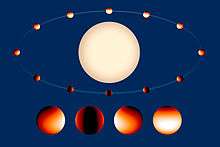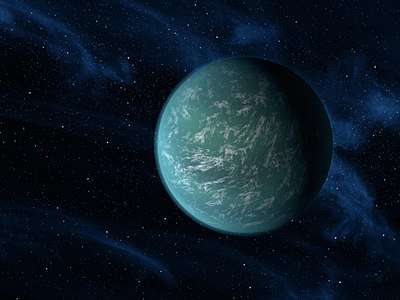WASP-43b
WASP-43b is a transiting planet in orbit around the young, active, and low-mass star WASP-43 in the constellation Sextans. The planet is a Hot Jupiter with a mass twice that of Jupiter, but with a roughly equal radius. WASP-43b was flagged as a candidate by the SuperWASP program before they conducted follow-ups using instruments at La Silla Observatory in Chile, which confirmed its existence and provided orbital and physical characteristics. The planet's discovery was published on April 14, 2011.[2]
 Exoplanet WASP-43b orbits its parent star.[1] | |
| Discovery | |
|---|---|
| Discovered by | Coel Hellier et al.[2] |
| Discovery site | La Silla Observatory / South African Astronomical Observatory |
| Discovery date | Published April 15, 2011[2] |
| transit method[2] (secondary occultation detected later) | |
| Orbital characteristics | |
| Epoch J2000 | |
| 0.01526 (± 0.00018)[3] AU | |
| Eccentricity | < 0.0298 [3] |
| 0.81347753 (± 0.00000071)[3] d | |
| Inclination | 82.33 (± 0.20) [3] |
| Star | WASP-43 |
| Physical characteristics | |
Mean radius | 1.04 +0.07 −0.09[4] RJ |
| Mass | 2.03 (± 0.1)[4] MJ |
At the time of its discovery, WASP-43b had an orbital period of approximately 0.8 days (19.2 hours), the second-shortest orbit ever detected, surpassed only by WASP-19b.[2] In addition, at the time of discovery, WASP-43b was the most closely orbiting Hot Jupiter known,[2] a phenomenon that can most likely be explained by its host star's low mass.
Observational history
WASP-43 was first flagged as host to a potential transiting event (when a body crosses in front of and dims its host star) by data collected by SuperWASP, a British organization working to discover transiting planets across the entirety of the sky. In particular, WASP-43 was observed first by the leg of WASP-South at the South African Astronomical Observatory between January and May 2009.[2]
Later observation by both SuperWASPs in the Northern and Southern Hemispheres led to the collection of 13,768 data points between January and May 2010 and to the use of the CORALIE spectrograph at La Silla Observatory in Chile. Fourteen measurements using the radial velocity method confirmed WASP-43b as a planet, revealing its mass in the process. The use of La Silla's TRAPPIST telescope helped the science team working on the planet to create a light curve of the planet's transit in December 2010.[2]
The planet's discovery was published in the journal Astronomy and Astrophysics on April 14, 2011.[2]
In 2014, secondary transit of the planet was reported.[5] Full observation of phases of the planet was reported in September 2014.[6]
Host star
WASP-43 is a K-type star in the Sextans constellation that is about 80 parsecs (261 light years) away.[2] The star has a mass of 0.58 times that of the Sun, but is more diffuse with a radius of 0.93 times that of the Sun. The star's effective temperature is 4,400 K, making the star cooler than the Sun, and is metal-poor with regards to the Sun because it has a metallicity of [Fe/H] = −0.05 (89% the amount of iron in the Sun).[4] The star is young, and is estimated to be 598 million years old (as compared to the Sun's 4.6 billion years).[4] Analysis of emission lines have indicated that WASP-43 is an active star.[2]
WASP-43 has one detected planet in its orbit, WASP-43b. The star has an apparent magnitude of 12.4, and thus is too faint to be seen with the unaided eye from Earth.[4]
Characteristics
WASP-43b is a dense Hot Jupiter with a mass of 1.78 times the mass of Jupiter, but a radius of 0.93 times that of Jupiter's. The planet orbits its host star at a mean distance of 0.0142 AU every 0.813475 days (19.5234 hours);[4] this orbital period, at the time of WASP-43b's discovery, was the second-shortest orbit yet detected, surpassed only by WASP-19b. In addition, WASP-43b had the closest orbit to its host star (among Hot Jupiters) at the time of its discovery, comparable only to the Super-Earth planet GJ 1214b and to the planetary candidate orbiting KOI-961. While Hot Jupiters are known to have small orbital periods, planets with exceptionally small periods below three or four days are extremely rare; however, in the case of WASP-43b, the planet's proximity can be explained because its host star has a very low mass. The rarity of systems like that of WASP-43 and its planet suggest that Hot Jupiters do not usually occur around low-mass stars, or that such planets cannot maintain stable orbits around such stars.[2]
WASP-43b, along with the planets WASP-19b and WASP-18b, conflicted with currently accepted models of tidal movements derived from observations of the orbits of binary star systems. Revisions to the model with regard to planets were proposed to help the models conform to the orbital parameters of these planets.[2] No orbital decay driven by tidal dissipation was detected in 2016, placing a lower limit of 10 million years on remaining planetary lifetime.[7]
In 2019, the spectrum of Wasp-43b was taken, with best fit being the water containing clouds without significant amounts of alkali metals.[8] In 2020, further analysis of the spectra have revealed the presence of bivalent aluminum oxide (AlO) and water in atmosphere,[9] while carbon monoxide, carbon dioxide and methane were not detected. Climate modelling suggests the carbon monoxide concentration may be variable, while atmospheric spectrum of WASP-43b is dominated by clouds made of refractory mineral particles, with small contribution from hydrocarbon haze.[10]
In comparison, planet Mercury has an orbital period of 87.97 days and lies at a mean distance of 0.387 AU from the Sun.[11]
External links
References
- "Hubble reveals most detailed exoplanet weather map ever". ESA/Hubble Press Release. Retrieved 14 October 2014.
- Hellier, C.; Anderson, D.R. (2011). "WASP-43b: The closest-orbiting hot Jupiter". Astronomy and Astrophysics. 535: L7. arXiv:1104.2823. Bibcode:2011A&A...535L...7H. doi:10.1051/0004-6361/201117081.
- Gillon, M.; Triaud, A.H.M.J. (2012). "The TRAPPIST survey of southern transiting planets. I. Thirty eclipses of the ultra-short period planet WASP-43 b". Astronomy and Astrophysics. 542 (A4): A4. arXiv:1201.2789. Bibcode:2012A&A...542A...4G. doi:10.1051/0004-6361/201218817.
- Jean Schneider (2011). "Notes for star WASP-43". Extrasolar Planets Encyclopaedia. Retrieved 7 May 2011.
- Chen, G; Van Boekel, R; Wang, H; Nikolov, N; Fortney, J. J; Seemann, U; Wang, W; Mancini, L; Henning, Th (2014). "Broad-band transmission spectrum and K-band thermal emission of WASP-43b as observed from the ground". Astronomy and Astrophysics. 563: A40. arXiv:1401.3007. Bibcode:2014A&A...563A..40C. doi:10.1051/0004-6361/201322740.
- "Hubble Maps the Temperature and Water Vapor on an Extreme Exoplanet". 2015-04-22.
- Hoyer, Sergio; Pallé, Enric; Dragomir, Diana; Murgas, Felipe (2016). "Ruling Out the Orbital Decay of the Wasp-43B Exoplanet". The Astronomical Journal. 151 (6): 137. arXiv:1603.01144. Bibcode:2016AJ....151..137H. doi:10.3847/0004-6256/151/6/137.
- Chen, Guo; Roy van Boekel; Wang, Hongchi; Nikolov, Nikolay; Fortney, Jonathan J.; Seemann, Ulf; Wang, Wei; Mancini, Luigi; Henning, Thomas; Alam, Munazza K.; Kirk, James; McGruder, Chima; Rodler, Florian; Fienco, Jennifer (2019). "ACCESS: A Visual to Near-infrared Spectrum of the Hot Jupiter WASP-43b with Evidence of H2O, but no evidence of Na or K". The Astronomical Journal. 159: 13. arXiv:1911.03358. doi:10.3847/1538-3881/ab55da.
- Chubb, Katy L.; Min, Michiel; Kawashima, Yui; Helling, Christiane; Waldmann, Ingo (2020). "Aluminium oxide in the atmosphere of hot Jupiter WASP-43b". arXiv:2004.13679 [astro-ph.EP].
- A bot will complete this citation soon. Click here to jump the queue arXiv:2005.14595.
- David Williams (17 November 2010). "Mercury Fact Sheet". Goddard Space Flight Center. NASA. Archived from the original on 6 November 2015. Retrieved 7 May 2011.
- "Hubble Hangout on planet WASP-43b". 2014. Retrieved 7 Nov 2014.


.jpg)